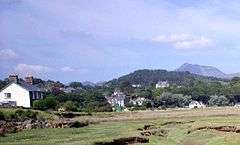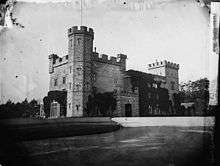Penrhyndeudraeth
Penrhyndeudraeth ([pɛnr̥ɨndəɨˈdrɑːɨθ] (![]()
| Penrhyndeudraeth | |
|---|---|
 Penrhyndeudraeth from River Dwyryd | |
 Penrhyndeudraeth Location within Gwynedd | |
| Area | 7.65 km2 (2.95 sq mi) |
| Population | 2,150 (2011) |
| • Density | 281/km2 (730/sq mi) |
| OS grid reference | SH611388 |
| Community |
|
| Principal area | |
| Country | Wales |
| Sovereign state | United Kingdom |
| Post town | PENRHYNDEUDRAETH |
| Postcode district | LL48 |
| Dialling code | 01766 |
| Police | North Wales |
| Fire | North Wales |
| Ambulance | Welsh |
| UK Parliament | |
| Senedd Cymru – Welsh Parliament |
|
History
An older settlement of a few cottages at Upper Penrhyn was originally called Cefn Coch ('Red Ridge') and that name is perpetuated by the Penrhyndeudraeth primary school, which is known as Ysgol Cefn Coch; but the town proper is comparatively modern. The ground on which it stands was a malarial swamp encircling a huge stagnant pool. The present town owes its existence as a commercial centre to a local landowner, David Williams of Castell Deudraeth near Minffordd, who in the mid-19th century drained the swamp and dried the pool and constructed many streets. Adopting a scheme of town planning evolved by the builder of Tremadog and his Italian craftsmen, Williams gave Penrhyndeudraeth broad streets and wide open spaces. The main square is a road junction with choice of four roads - one leading to the station, one to Porthmadog, one to Maentwrog and the other to Llanfrothen and the Pass of Aberglaslyn. Williams' daughter Alice Williams built the first Institute Hall for one of the first British Women's Institutes in the country in Penrhyndeudraeth.[3]
The lower half of Penrhyndeudraeth used to be a lake, which was then drained to create the area where the village's High Street is today. The names of terraces in Penrhyndeudraeth, such as Glanllyn ("lakeside") and Penllyn ("end of the lake"), refer to a time when the site was underwater. There is also an area named Penlan ('the end of the tide'), which may point to the reason why the lower half of Penrhyndeudraeth is flat. It is believed that the lower half of Penrhyndeudraeth was founded on a spot behind the Royal Oak pub where the old Pierce & Sons garage is located.
Prior to the many 19th century land reclamation projects (including The Cob at Porthmadog) and the building of the Ffestiniog Railway, both of which spurred economic growth, the few local inhabitants relied on agriculture and small-scale copper mining. Some men worked boats on the River Dwyryd, carrying slate from Maentwrog to the sea for export. Local women at that time gathered cockles in the estuary for sale in local markets. Penrhyndeudraeth is still known locally, especially by the people of Blaenau Ffestiniog and Porthmadog, as Penrhyn Cocos (or "Cockletown" in English).

Halfway between Penrhyndeudraeth and Minffordd, next to the Snowdonia National Park Headquarters, but standing apart, is Hendre Hall, where in 1648 Humphrey Humphreys was born. He became Bishop of Bangor from 1689 to 1701 and then of Hereford. He died in 1712. One of the family carvings at the Holy Trinity Church Penrhyndeudraeth is of him and there is also an oak chest which Richard Humphreys gave to Llanfrothen Church whilst working as its warden in 1690.
The property named "Cae Ednyfed", between Penrhyndeudraeth and Minffordd, was once the property of Ednyfed Fychan, commander-in-chief to Llywelyn ap Iorwerth.
The town has not always been very religious. Early in the history of the Methodists, they established chapels, and fellowship meetings (seiadau) were established. There is a history of revivalists such as Daniel Rowland who held meetings at Tyddyn Isaf and the poet Dafydd Siôn Siâms who publicly cursed the new religion before himself being converted. He chastised the Methodists mercilessly before burning all their critical poetic works in a public bonfire in the village square. The Old Methodists' original communion chalice is to be seen in the National Library in Aberystwyth. The town was originally in two Anglican parishes, Llanfrothen and Llandecwyn. Holy Trinity church was built in 1858 and a new parish of Penrhyndeudraeth was created in 1897.
For nearly 75 years the explosives works were the economic backbone of the village; more recently jobs became available at Trawsfynydd nuclear power station. Historically, the population depended on employment offered by the slate industry at Blaenau Ffestiniog and the trade in raw materials through the busy harbour at Porthmadog.
Governance
An electoral ward in the same name exists. This ward extends north to Llanfrothen with a total population of 2,587.[4]
Industry
The main manufacturing industry in Penrhyndeudraeth was established in 1872 to make guncotton. Cookes Explosives Ltd, which later became part of the Imperial Chemical Industries (I.C.I.), dealing with increased demand for munitions during World War I, set up a new explosives factory at Penrhyndeudraeth, bringing an economic boom to the town. The plant produced thousands of tons of munitions for the war and explosives for quarrying and mining. In 1949, R. T. Cooke applied for a licence to store explosives at Croesor Quarry, in Penrhyndeudraeth. Many lives were lost in accidents at the works, and there is a slate plaque to remember them and everyone who worked there. The prolonged miners' strike of 1984 and the competition from foreign coal imports resulted in wholesale pit closures which, in turn, reduced the demand for mining explosives to the point where production was no longer economic and the site was finally cleared in 1997. It is now a nature reserve notable for the presence in summer of nightjars.
Another 19th-century industry in the district is Garth Quarry at Minffordd, established in 1870 to make granite setts for road building in towns and cities. Like the explosives industry, the quarry relied heavily on the coming of the Cambrian Railways in 1872. The quarry is still working and now produces roadstone and railway ballast.
Transport
The town is at the junction of the A487 with the A4085 which connects with Beddgelert and Caernarfon. The first section of this road is very narrow and rises steeply through Upper Penrhyn. In places it is so narrow that only a single vehicle can pass.
To the south is the new Pont Briwet bridge providing a short-cut to the Harlech road. The bridge is also shared with the Cambrian Coast railway mainline. A new £20m road and rail bridge was opened in 2015, replacing the old wooden structure. For generations, the Grade II listed Pont Briwet carried the Cambrian Coast Railway, allowing people to cross Afon Dwyryd from Penrhyndeudraeth to Llandecwyn along a narrow road suitable for cars only. The new bridge allows all road vehicles to cross and the original toll is no longer applied.
The town has two stations, Penrhyndeudraeth railway station on the southern side of the village on the Cambrian Coast Railway from Pwllheli to Shrewsbury and to the north, Penrhyn railway station, on the A4085 near the top of the hill, on the Ffestiniog Railway.
Culture and heritage
According to the 2011 Census, Penrhyndeudraeth is the 19th most Welsh-speaking community in Wales, with approximately 76% of its residents aged three years or older stating that they could speak Welsh.[5] According to the latest Estyn inspection report of the village's primary school, Ysgol Cefn Coch, 79% of pupils come from homes where Welsh is spoken.[6] In an incident in June 2011, with new English landlords of the Royal Oak pub in Penrhyndeudraeth, customers left the pub in anger and were threatened with an airgun after being told to stop ordering their drinks in Welsh. The pub subsequently had a change of management.[7][8]
The Penrhyndeudraeth Children and Young People's Chaired Eisteddfod is held annually at the Memorial Hall. The village is home to the Snowdonia National Park Authority headquarters.
There are many language traces of Old Welsh to be found in the place names in the Penrhyndeudraeth area, such as “Pont Briwet /Briwet Bridge (Briwet is cognate with the Breton word "Brued" meaning bridge). Remains of old huts can be found near Ty’n y Berllan, which date back to the Bronze Age.
Penrhyndeudraeth's Alun 'Sbardun' Huws wrote a song, Strydoedd Aberstalwm (approximately "streets of long ago"), in tribute to the village.[9] His well-known band Y Tebot Piws also recorded their farewell album at Penrhyndeudraeth Memorial Hall in 2011.[10]
Football
Penrhyndeudraeth F.C. has a senior team and several junior teams. The senior team are currently in their second season in the 2nd Division of the Welsh Alliance League, after finishing third in their first season at this level in 2012-13 and also winning the Take Stock Van Hire Cup (for Division 2 clubs), runners-up in the Mawddach Challenge Cup and also receiving a trophy for the best official matchday programme in the League's 2nd Division. This followed a very successful campaign in the Gwynedd League (2011–12) when they finished as League Champions and also won the "Gwynedd Safeflue" and "Bob Owen Memorial" Shields.
The junior teams (under 14, 12, 11, 9 and 7s) all play in the Llyn and Eifionydd Junior Football League.
Famous residents
- Philosopher Bertrand Russell (1872–1970), lived at Plas Penrhyn in the village from July 1956, until his death there[11]
- Poet and Calvinistic Methodist minister Nathaniel Jones (1832–1905)
- Fanny Edwards, school-mistress and Welsh language author (1876–1959)[12]
- Alun "Sbardun" Huws (1948–2014), founding member of the Welsh rock band Y Tebot Piws, songwriter, programme director at HTV and BBC
Gallery
 High Street
High Street- The oak pub
 The railway station in 1875.
The railway station in 1875._NLW3363901.jpg) The fair in 1888.
The fair in 1888..jpg) Nearby woodland and mountain.
Nearby woodland and mountain. Snowdonia National Park HQ.
Snowdonia National Park HQ.
References
- "Community population 2011". Neighbourhood.statistics.gov.uk. Retrieved 17 May 2015.
- "Check Browser Settings". Neighbourhood.statistics.gov.uk. Archived from the original on 22 September 2010. Retrieved 6 April 2016.
- Archives, The National. "The Discovery Service". discovery.nationalarchives.gov.uk. Retrieved 20 October 2017.
- "Ward population 2011". UKcensusdata.com. Retrieved 17 May 2015.
- "2011 Census results by Community". Welsh Language Commissioner. Office for National Statistics. Archived from the original on 14 September 2017. Retrieved 8 November 2016.
- "Inpseciton Report Ysgol Cefn Coch" (PDF). Estyn. Estyn. 2012. Retrieved 8 November 2016.
- "In Wales, mind your language". The Daily Telegraph. London. 21 June 2011. Retrieved 30 September 2017.
- "Royal Oak Penrhyndeudraeth: Gareth Sale's suspended sentence". BBC News. 19 September 2012. Retrieved 30 September 2017.
- Eryl Crump (10 December 2015). "Sing along to the hits of Alun 'Sbardun' Huws". Daily Post. Retrieved 4 December 2016.
- "Alun Huws - obituary". The Daily Telegraph. London. 11 January 2015. Retrieved 4 December 2016.
- Russell, Bertrand. Andrew G. Bone (ed.). The Collected Papers of Bertrand Russell Volume 29: Détente Or Destruction, 1955-57. Abingdon: Routledge. p. iii. ISBN 978-0415-3583-78.
- "The National Library of Wales :: Dictionary of Welsh Biography". Wbo.llgc.org.uk. Retrieved 6 April 2016.
External links
| Wikimedia Commons has media related to Penrhyndeudraeth. |
